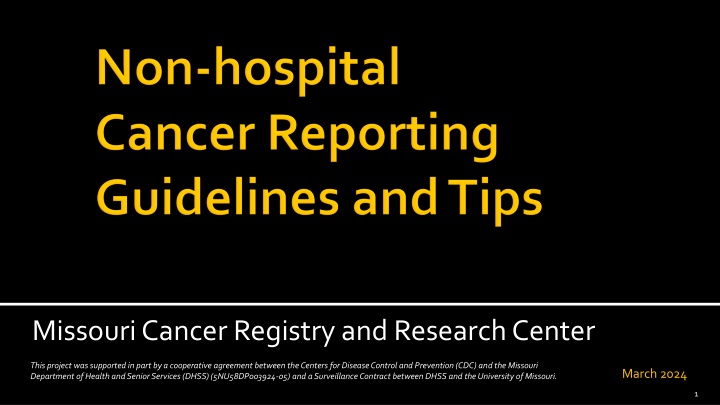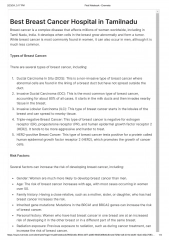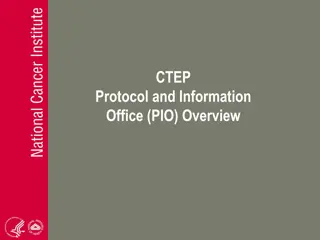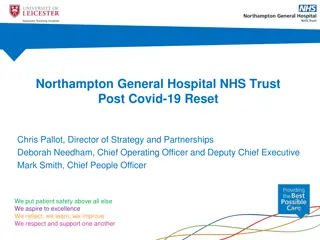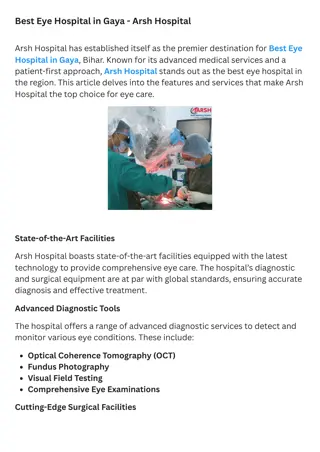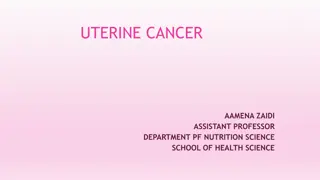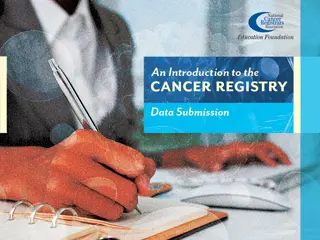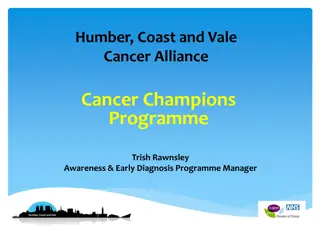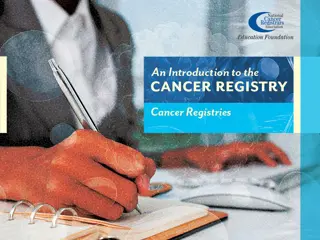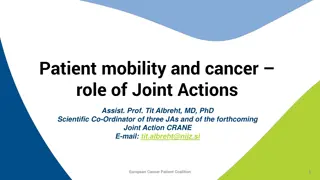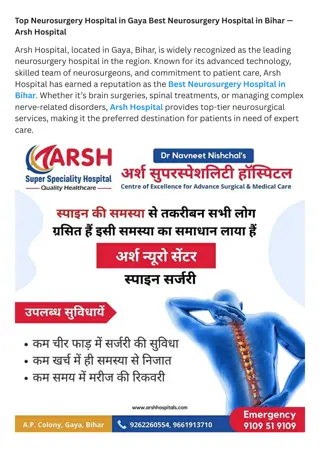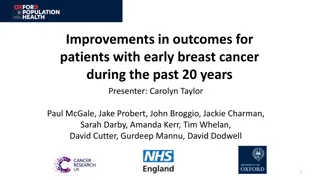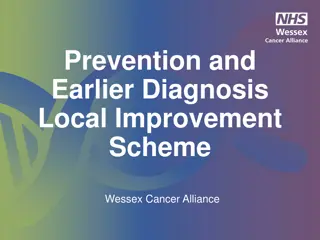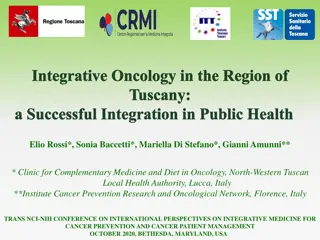Non-hospital Cancer Reporting Guidelines and Tips
The Missouri Cancer Registry and Research Center plays a crucial role in collecting and analyzing cancer data to support research and improve healthcare outcomes. Learn about reporting requirements, data collection procedures, and the importance of confidentiality in this detailed guide.
Download Presentation

Please find below an Image/Link to download the presentation.
The content on the website is provided AS IS for your information and personal use only. It may not be sold, licensed, or shared on other websites without obtaining consent from the author.If you encounter any issues during the download, it is possible that the publisher has removed the file from their server.
You are allowed to download the files provided on this website for personal or commercial use, subject to the condition that they are used lawfully. All files are the property of their respective owners.
The content on the website is provided AS IS for your information and personal use only. It may not be sold, licensed, or shared on other websites without obtaining consent from the author.
E N D
Presentation Transcript
Missouri Cancer Registry and Research Center This project was supported in part by a cooperative agreement between the Centers for Disease Control and Prevention (CDC) and the Missouri Department of Health and Senior Services (DHSS) (5NU58DP003924-05) and a Surveillance Contract between DHSS and the University of Missouri. March 2024 1
Non-hospital Cancer Data Reporters 3 I. Learning Objectives 4 II. General Background Missouri Reporting Legislation National Program of Cancer Registries Goal of Data Collection Why Non-hospital Reporting? Types of Cancers Diagnosed and Treated Outside the Hospital What Happens to Cancer Data Reported to the MCR? Confidentiality and Legislation 5 7 8 9 10 11 12 13 III. Why report? Cancer Data Required to be Reported Time Period for Reporting How your Data is Used in the Fight Against Cancer 14 15 17 18 IV. Why do all Non-hospital Facilities Need to Report? 19 V. Reporting Neoplasms Using Text to Select Cases to Report to MCR Using Codes to Select Cases to Report to MCR Exclusions to Reporting 21 23 26 30 VI. Timetable for Reporting Cases to MCR Reporting Schedule 31 32 VII. Data Submissions Cancer Reporting Methods General Instructions Case Identification Common Data Errors Common Data Omissions 33 35 36 38 41 42 2
Physicians Ambulatory Surgery Centers Radiation Treatment Facilities Pathology Labs Long-term Care Facilities 3
These guidelines will help you: Learn why cancer cases are reported to the Missouri Cancer Registry Learn which neoplasms are currently reportable Understand in which situations to report cases Learn procedures for reporting cancer case data 4
In this section you will learn about: The background and history of the Missouri Cancer Registry Missouri Reporting Legislation The importance of cancer data reporting by non-hospital facilities What happens to your data after it is reported to MCR Issues of confidentiality of data reported to MCR 5
The MCR is the states central cancer information center Founded in 1972 (data submissions from hospital-based registries were voluntary) Legally established in 1984 when the Missouri General Assembly passed a bill to require hospital inpatient cancer reporting Due to changes in the health care delivery system, an increasing number of cancer cases are now being treated outside the hospital setting. Therefore, an expanded cancer reporting law was passed in 1999 requiring pathology laboratories, ambulatory surgery centers, freestanding cancer clinics and treatment centers, physicians and long-term care facilities to also report cancer cases 6
Missouri Bill Requiring Inpatient Reporting by Hospitals 1984 The purpose of the Missouri Cancer Registry is to ensure an accurate and continuing source of data concerning cancer and certain specified benign tumors. Expanded Cancer Reporting Law of 1999 Required that physician offices, pathology laboratories, ambulatory surgical centers, residential care facilities and assisted living facilities, intermediate care facilities, skilled nursing facilities, and free-standing cancer clinics and treatment centers report to the MCR. Cancer as a Communicable Disease In June 2008, cancer was included in the Missouri Department of Health and Senior Services (DHSS) list of reportable diseases and conditions. This crucial update duly reinforces the importance of cancer reporting by all entities within the state. 7
The NPCR provides funding and support for state cancer registries to: Monitor cancer trends over time Determine cancer patterns in various populations Guide planning and evaluation of cancer control programs Help set priorities for allocating health resources Advance cancer research Provide information for a national database of cancer incidence Like other NPCR state registries, Missouri s central registry is population-based Missouri began receiving funds from NPCR in 1995. For further information regarding NPCR: http://www.cdc.gov/cancer/npcr 8
The MCR collects information on: Newly diagnosed cancer cases Cancer treatment Cancer deaths 9
Shift in recent years toward outpatient diagnosis and treatment for cancer patients Pathology labs, physicians' offices, ambulatory surgery centers, long- term care facilities and radiation treatment centers together with hospitals play a key role in the collection of cancer information Without non-hospital reporting, Missouri cancer statistics would not be accurate and the MCR database could not be relied upon to help direct cancer prevention and control efforts Increases completeness of data for cancer incidence in Missouri 10
The most common types of cancer diagnosed or treated outside of the hospital are: Melanoma Prostate Non-invasive bladder tumors Colorectal tumors Lymphoma, leukemia, multiple myeloma and other bone marrow primaries 11
A case summary, or abstract for each cancer case that is reported to MCR is created and added to the MCR database Cases already reported by another source are updated with additional demographic, diagnostic, treatment and follow-up data Case information for out of state residents is reported to each respective state cancer registry to assure complete case finding 12
MCR maintains the confidentiality of data MCR has procedures in place to assure that the confidentiality provisions of state law, ARRA HITECH and HIPPA are implemented.Staff sign confidentiality agreements annually and data is data is kept in secured offices, workstations, applications and network Only aggregated data that does not reveal patient identity is released for published reports or to respond to general data requests Researchers needing confidential data from MCR must undergo a stringent approval process outlined on our website HIPAA privacy regulations allow the MCR as a public health authority to collect information for the purpose of preventing and controlling cancer. Public health reporting under the authority of state law is specifically exempted from the Privacy Rule regulations. 13
Learning Objectives In this section you will learn about: Cancer Data Required to be Reported to MCR How MCR data is used in cancer surveillance and control effort 14
Types of data that are currently collected by MCR include: Cancer site Demographic data Diagnostic information, including pathology report data Staging data to assess the extent of the disease Treatment(s) 15
Non-hospital offices may be contacted by MCR to obtain additional information such as: Complete first course of treatment data Diagnostic and treatment information for cancer cases identified through death certificate review 16
The 1999 Amendment specifies reporting of cancer cases within 6 months of initial diagnosis or treatment, whichever is earlier Reporting frequency will depend on reporting category and number of cases. Larger pathology laboratories may be requested to submit data on a monthly basis Small laboratories on a quarterly basis Other non-hospital facilities will be required to report at least quarterly. Physicians will be contacted on an as needed basis regarding additional data not available from other facilities (i.e., pathology labs will not have treatment information) 17
Examples of how MCR data is used: Incidence and Mortality Report issued by MO DHSS http://health.mo.gov/data/mica/MICA/ The Missouri Cancer Consortium and Missouri Department of Health and Senior Services use MCR data to help target resources for improvements in screening, prevention and treatment Investigations by Missouri Department of Health and Senior Services of possible cancer clusters in Missouri Treatment and follow-up data collected for use in planned quality of cancer care and survivorship studies NAACCR s CINA report http://www.cancer-rates.info/naaccr/ NPCR s National Cancer Institute s publication United States Cancer Statistics (USCS): Incidence and Mortality Data https://www.cdc.gov/cancer/uscs/index.htm 18
Learning Objective In this section, you will learn why reporting from non-hospital facilities is essential for complete data collection 19
Even if your center has only minimal clinical data for a patient, such as date of diagnosis, cancer site and type, we need you to report this information as it helps us to create the most complete patient record possible and may add details to our final consolidated case Cancer patients often travel between states for treatment (MCR has 8 border states and two major cities on borders) A patient could be referred to a MO hospital for treatment services but ultimately not go there for these services Data from different reporting sources is consolidated at MCR for a complete, accurate cancer abstract for each case, using reports from various sources. 20
Learning Objectives In this section, you will learn: Which neoplasms are reportable Exclusions to reporting 21
Your office may select cases to report to MCR based on: Text from the patient s pathology report, medical records, or other documentation Codes: A comprehensive list of ICD-10 codes is provided on our website.Use it to run a search of your billing system for cases with these codes https://cancerregistry.missouri.edu/reporting/cancer- reporting-hospital/ 22
Report neoplasms described with the following terms, for ALL CANCER SITES* In situ Intraepithelial Stage 0 Non-invasive Non-infiltrating *see exclusions on slide 30 23
FOR ALL CANCER SITES Cancer Malignant Carcinoma Malignant neoplasm Adenocarcinoma 24
For diagnoses after January 1, 2004 in any of the following sites: Brain Meninges Craniopharyngeal duct Cranial nerves Other parts of the central nervous system Spinal Cord Pineal gland 25
ICD-10 Codes C00 D49* Includes: Malignant neoplasms Benign brain/CNS neoplasms Carcinoma in situ Hematopoietic neoplasms *See the Missouri Cancer Registry Non-hospital Reporting Manual on our website for additional information on exclusions to reporting 26
Report each primary cancer site separately. Any concurrent or subsequent diagnosis of or treatment for cancer in another primary site should be reported as a separate case. Example: A patient has biopsies of the skin on the right and left cheek. Pathology results show a malignant melanoma, Clark s Level II of the right cheek, and a melanoma in situ of the left cheek. Each primary melanoma should be reported as a separate case. 27
Ambiguous Terms that Constitute a Diagnosis For a cancer case to be reportable, the ambiguous term must always include a reference to the reportable diagnosis being described, e.g., favors carcinoma or suspicious for malignancy. Ambiguous Terms That Constitute a Diagnosis Apparent (ly) Appears Comparable with Compatible with Consistent with Favors Neoplasm* Most likely Presumed Probable Suspect (ed) Suspicious (for) Typical of Tumor * *additional terms for nonmalignant primary intracranial and central nervous system tumors only 28
Ambiguous Terms that DO NOT Constitute a Diagnosis Cannot be ruled out Equivocal Possible Potentially malignant Questionable Rule Out Suggests Worrisome 29
DO NOT REPORT: Basal cell and squamous cell carcinoma of skin In situ carcinoma of the cervix uteri Cervical intraepithelial neoplasia (CIN III) Prostatic intraepithelial neoplasia (PIN III) DO NOT REPORT when a patient has only a history of cancer with no currently active disease 30
Reporting frequency will depend on reporting category and number of cases Larger pathology laboratories may be requested to submit data on a monthly basis Small laboratories on a quarterly basis Other non-hospital facilities will be required to report at least quarterly Example: A biopsy is performed at your surgery center on April 15, 2024; diagnosis adenocarcinoma of the prostate. This case would need to be reported to the MCR by August 31, 2024. 31
The schedule for reporting cases to the MCR is based on your caseload/year # of Reportable Cases/Year Reporting Interval >75 Monthly 25-74 Every other month <25 Quarterly 32
To avoid additional follow-up calls from MCR staff, submissions must be: Timely Accurate Complete 33
Web Plus secure online reporting https://webplus.umh.edu/webplus/logonen.aspx 34
Web Plus Do not assume a hospital or other clinician will report Enter abstract in Web Plus for EACH CANCER DIAGNOSED Copy and paste information from EMR and Pathology Report into text boxes provided and/or comments section If no documentation, explain why in Comments section in Web Plus 35
Identify patient personal data and demographics Sex Race 1,2 complete both if multiracial Ethnicity Latino origin Occupation majority of career Company/Industry Patient address at diagnosis 36
Identify when the diagnosis was made, tumors anatomical location, cell/tissue type, size/depth, and disease stage Date of Diagnosis Provide supporting documentation in text boxes: path/lab report, AJCC summary staging documentation, diagnostic imaging reports, op note and scope reports, history and physical 37
Specify the type* and date of treatment the patient had Specify patient s vital status, last contact with your facility, referrals Provide Clinician s name and specialty if patient was referred to/from your facility A decision for no treatment is a considered a treatment plan *type= Surgical Procedure(s) 38
Error Solution Occupation = Retired Record patient s usual/former occupation Date of DX = date positive malignancy reported Record date specimen was collected Place of DX = name of path lab/facility that analyzes specimen Record facility/office where specimen was collected 39
Omission Solution Incomplete practitioner information Sex, SSN Race, Ethnicity Occupation, Industry Grade, Stage PT status, Date of last contact (if PT is alive) Referrals Supporting documentation (path/lab report) Report your data: Details are important for accurate and complete cancer incidence data for all Missouri residents 40
Data omissions Data inconsistencies Not reporting 41
For more information, please visit our website: https://cancerregistry.missouri.edu/ Or give us a call: 1-800-392-2829 or 573-882-7775 42
By working together, we can assure complete, accurate cancer data for Missouri! 43
